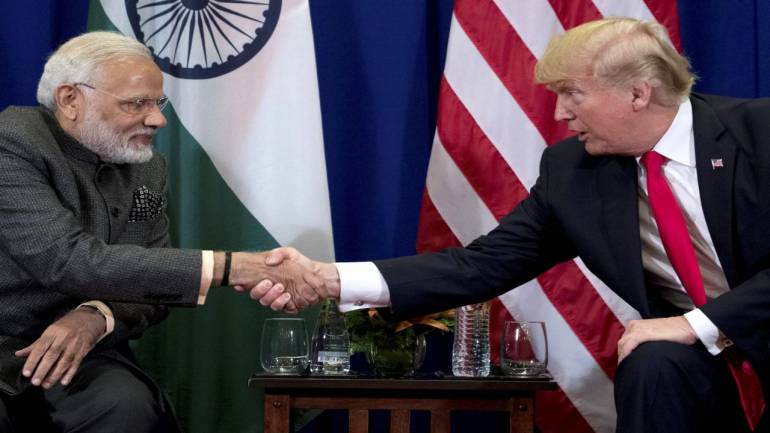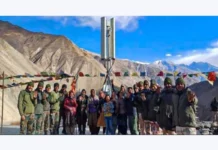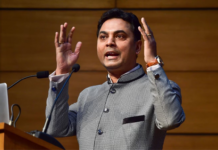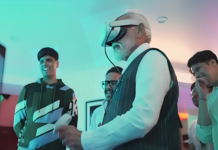WASHINGTON: Notwithstanding irritants on trade issues, India and the US made “landmark” progress in 2018 to bolster their strategic and defense ties from holding the maiden trilateral meeting with Japan to the first-ever 2+2 dialogue during which they signed the long-pending COMCASA agreement that would open the way for sales of more sensitive US military equipment to India.
The trade disputes posed bumps on the road as President Donald Trump called India a “tariff king” in September. However, two months later, he praised Indians as tough negotiators as the two countries started talks on a bilateral trade deal.
India was among the few countries, which received a waiver on Iran sanctions from the Trump administration, which also pressed Pakistan to bring to justice the perpetrators of the 2008 Mumbai attack and announced a reward of USD 5 million for information leading to the arrest or conviction in any country of any individual who committed, conspired to commit, or aided the 26/11 attack.
“This has been a landmark year for US-India ties as we build out stronger relationships across the board,” Alice Wells, the Principal Deputy Assistant Secretary of State for South and Central Asia, told PTI.
“Last month, President Trump met in Buenos Aires with Prime Minister Narendra Modi and Prime Minister Shinzo Abe in the first US-India-Japan or ‘JAI’ meeting as Prime Minister Modi called it between the three leaders, and Vice President (Mike) Pence reviewed the rapid development of the strategic partnership during his meeting with Prime Minister Modi in Singapore,” said Wells, who has been Trump administration’s point person for the South and Central Asia.
Secretary of State Mike Pompeo described the first 2+2 Ministerial Dialogue in September as “symbolic of our increasingly close partnership,” she said.
Pompeo along with Defense Secretary James Mattis were hosted by their Indian counterparts, External Affairs Minister Sushma Swaraj and Defence Minister Nirmala Sitharaman in New Delhi.

“The 2+2 focused on operationalizing India’s status as a Major Defence Partner of the US, cooperation on global challenges, and our shared vision for a free and open Indo-Pacific,” Wells said.
“The event culminated with the signing of the Communications Compatibility and Security Agreement (COMCASA), which will facilitate greater interoperability between our forces, enhance information and intelligence sharing, and ensure that India has access to top-tier US military technology,” she said.
“The finalization of this agreement was a historic step and, since then, we have made significant strides toward finalizing additional agreements that will enable our militaries and private sectors to work even closer together,” she added.
India’s strategic partnership with the US and its emergence as a leading global power was on display during other high-level gatherings this year, including two meetings of the quadrilateral partners (Australia, India, Japan, and the US) and at the India-Japan-US trilateral meeting at the G-20 summit last month.
“At these meetings, US and Indian officials discussed our shared commitment to maintaining and strengthening a rules-based order in the Indo-Pacific based on respect and partnership, not domination,” she said.
On the economic front, India-US trade relationship continues to grow, she said. Bilateral trade grew to USD 126 billion last year and, parallel with the launch of the Strategic Energy Partnership, US-sourced oil and liquefied natural gas landed on Indian shores. “Still, we can do much more. US companies need better access to India’s markets in order for us to realize the full potential of our economic partnership,” Wells said.
She said the Trump administration looks forward to building on this relationship’s momentum and working even more closely with the Indian counterparts on a range of shared strategic interests next year.
Nisha Desai Biswal, president of the US-India Business Council, believes 2018 experienced major upheavals impacting longstanding trade agreements and frameworks, with retaliatory tariffs, rising protectionism, and domestic political clashes spilling over into the economic policy of major economies.
“Despite these trade headwinds, the US-India commercial and strategic relationship continues to enjoy strong bipartisan support in the US, underpinned by rapidly expanding bilateral trade,” she said.
On the US-India strategic front, proponents of greater interoperability scored some major wins, including the conferring of STA-1 status to India by Commerce Secretary Wilbur Ross. “This puts India on par with America”s closest allies,” she said.
Biswal said that on the commercial front, the private sector will be watching closely to see whether the two governments can reach a bilateral trade deal and resolve key trade irritants impacting US business.
“Business community engagement will be particularly critical in 2019, with a challenging political environment in both countries making protectionist policy a significant concern,” she said.
The resumption of the US-India Commercial Dialogue next February, a US-India CEO Forum and the potential for a Trade Policy Forum will make 2019 a particularly important year, Biswal said.
All eyes are right now on the upcoming elections and how that will impact the economy and overall investment climate, she noted.
Alyssa Ayres from the Council of Foreign Relations said bilateral ties have made good progress on strategic and defense front, but economic ties are bumpier. PTI







